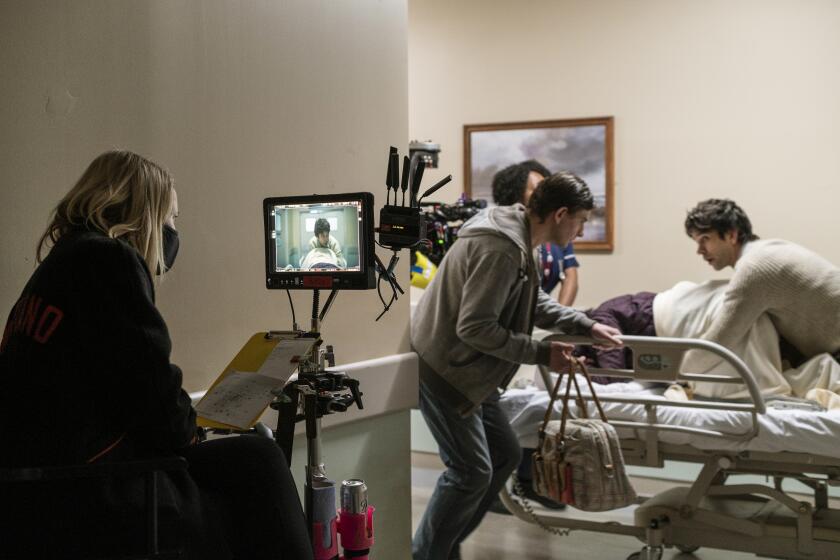Right as Rain, Quite Often : Private Weather Forecaster Peers Ahead 5 Years and Confounds Those Who Say, ‘It Can’t Be Done’
Maybe Paul Ruch could have found a business that would be more distasteful to his scientific colleagues than what he’s doing. But it would have been difficult.
Ruch (pronounced Ruke) is a meteorologist who does weather forecasts for private clients. Long-range weather forecasts.
President of Ruch Weather Services in Tustin and the only commercial forecaster in Orange County, Ruch says he can give his clients daily rainfall and temperature predictions up to 5 years in advance.
And that’s where he parts company with much of his profession.
Most meteorologists consider a 10-day forecast to be “long-range.” Beyond that, they contend that only general monthly or seasonal predictions can be done with any degree of accuracy, and then only for 90 days or so.
The official position of both the American Meteorological Society and the National Weather Service is that extreme long-range predictions can’t be done.
“It is pretty much worthless to try to distinguish one day from the next” for more than a few weeks at a time, said Donald Gilman, chief of the National Weather Service’s prediction branch.
Claim Practical Limit
Gilman said government and academic researchers have turned in “some fairly strong research that implies that there is a current practical limit to forecasting accuracy, and an intrinsic limit, too, on the order of 2 to 3 weeks.”
Ruch, however, maintains that the limits are caused by an inability or unwillingness to take into consideration all of the factors that are involved in his company’s forecasting system.
Those extreme differences of opinion are the reason that long-range forecasters like Ruch make money.
Many people who believe that knowledge of next month’s or next year’s weather patterns will give them a leg up in their businesses aren’t willing to take the National Weather Service’s pronouncements as final.
So farmers, builders, amusement parks, shipping and trucking firms, utility companies and commodities speculators by the dozen turn to private forecasters. They pay an estimated $50 million a year for weather information they hope will give them a competitive edge.
Ruch said his client roster includes about 25 regular customers, mostly Southern California builders.
But he does not have a franchise on long-range forecasting. Fellow meteorologist Boyd E. Quate of Suffolk, Va., claims clients in 35 states and seven foreign countries. Quate bases his long-term predictions--which don’t extend as far into the future as Ruch’s--on sunspot cycles.
And just like Ruch and many other private forecasters, Quate has little patience with what he sees as professional naysayers in government and academia.
The National Weather Service “is 40 years behind the times,” Quate said. “My forecasts are not perfect, but 80% accuracy is a lot better than flipping a coin. If long-range forecasting isn’t worth anything, then why does the government spend millions of dollars each year researching it?”
Government Research
And government and academia do research it. The University Corporation for Atmospheric Research in Boulder, Colo., is a clearinghouse for a consortium of 57 universities involved in weather-related research. In addition, the government, through separate programs run by the the Navy, the Air Force and the National Oceanic and Atmospheric Administration, runs a huge number of weather and climate-related research programs.
Jerome Namias, head of a climate-related ocean research program at the Scripps Institute of Oceanography in La Jolla, suggested that if Ruch wants acceptance for his system, he should publish it in a scientific journal so it can be scrutinized by others in the field.
But Ruch rejects such suggestions, maintaining that if he did so, the system could be copied and he could be put out of business by larger, better-capitalized competitors.
So the system remains a secret. But that doesn’t discourage Ruch’s customers.
The Southern California Gas Co., for example, has used Ruch for almost 3 years to prepare a chart that predicts average daily temperatures for up to 6 months in advance. He provides monthly temperature ranges for 2 years in advance.
That information enables the gas company to schedule its purchases and to plan its underground storage in the most economic manner, said James Wilson, the utility’s manager of supply operations and analysis.
Other weather forecasters may call Ruch crazy, Wilson said, “but we find that he is the one service that really works . . . he’s accurate about 85% of the time.”
Planning in County
At the Santa Margarita Co., developer of Orange County’s newest planned community, construction activity and outdoor sales promotions and grand openings have been scheduled according to Ruch’s precipitation forecasts since 1985.
Michael Babbitt, the company’s vice president for construction, says Ruch is right about 85% of the time. Babbitt receives Ruch’s forecasts 2 years in advance, meaning that he now is looking at predictions for the 1989 and 1990 rainy seasons.
Ruch doesn’t claim perfection. But he maintains that his forecasts prove to be just as accurate and sometimes more so than National Weather Service forecasts made just a day in advance.
In forecasts prepared for a variety of clients in 1986, Ruch forecast 41 “rain risk” days for the first 7 months of 1988, according to forecasts he provided to The Times Orange County Edition. Those forecasts were checked with several clients, who said they matched the data Ruch had supplied them 2 years earlier.
The National Weather Service in its daily forecasts in the first 7 months of 1988 also predicted rain on 41 days.
But the NWS rain predictions matched only 9 of the 18 days in which it actually rained, for a 50% accuracy rate.
Ruch’s predicted rain risk days matched 16 of the 18 actual rainy days, giving him an 88.8% accuracy rate for forecasts made 2 years before the National Weather Service issued its daily predictions.
This year has been a drought year, and Ruch did not fare quite as well in predicting rainfall. He told clients in 1986 that only 55.5% of the historic normal rainfall would be tallied for the first half of 1988 in the Los Angeles Basin. Rainfall records at the Los Angeles Civic Center and Los Angeles International Airport show that rainfall for the six months was only 33.3% of normal.
Almanac Missed Drought
The Old Farmer’s Almanac, which is published late each October and contains general regional forecasts for the coming year, said rainfall for California would be about average for the first half of 1988, missing the state drought entirely.
The Ruch family’s involvement in weather stretches back more than 50 years, to when Ruch’s father, also named Paul, made his living piloting blimps for Goodyear Rubber Co.
Both his father’s blimp pilot license and his free-balloon license, Ruch said, were signed by Orville Wright.
“All pilots are interested in the weather,” Ruch said, “and when my dad’s job brought him out here to Los Angeles, he went back to school.”
The elder Ruch, now 83, earned a master of science in meteorology at Caltech. He served as associate professor of meteorology at Caltech from 1938 to 1948, succeeding Irving P. Krick as dean of the school’s meteorology department during World War II. Krick took temporary leave to join the Army Air Corps and help develop its wartime long-range weather forecasting capabilities.
In 1948, Krick and the elder Ruch left Caltech to begin the nation’s first private weather forecasting company, Irving P. Krick Associates. The company, now headquartered in Palm Springs, specializes in weather modification and long-range forecasting.
Shortly after his father left Caltech, the younger Paul Ruch began classes at UCLA, where he followed in his father’s footsteps and majored in meteorology, obtaining a bachelor of science degree in 1955. He then joined the Air Force, where he served as a weather officer in the United States, South America and Europe.
“When I got out,” he said, “I didn’t want to work under my dad’s shadow.” So Ruch turned to his second love, cooking, and joined the now-defunct Far West Services, which owned the Coco’s restaurant chain.
He spent 22 years with Far West, 11 in Hawaii as a restaurant manager and regional supervisor, and 11 at corporate headquarters in Newport Beach in a variety of executive positions. He was vice president of operations when he left in 1982 to go into the weather business full time.
Two Teamed Up
The senior Ruch had retired from Krick Associates in 1965 and father and son teamed up to develop what they believed would be the most accurate long-range weather forecasting system ever seen.
By 1982, the Ruchs decided their system was refined enough to begin long-range forecasting, and by 1984 they declared the system completed, “although it is constantly being updated and revised,” Ruch said.
Ruch calls the system a method of “dynamically calculating” future patterns.
“What we do is to take a small segment of time in the future and factor in things that are acting upon the atmosphere.” Those things, he said, include sunspot activity and solar radiation, ocean surface temperatures, wind currents, “a variety of factors, terrestrial and extraterrestrial.”
Once those factors are entered into the Ruchs’ computer program, they are adjusted to fit the particular geographic location for which a forecast is being prepared and then are weighted according to the complex formulas the Ruchs have devised.
Ruch said this involves a program that uses at least 90 years of weather history. “If we are forecasting for an October, for example, we find all the Octobers in history that have weather factors that closely match our model, and from that we devise our forecast,” he said.
And before Ruch starts casting predictions for a client, he runs simulations of as many as 1,200 to 1,800 prior months in that geographic area and checks them against what actually happened. This back-checking methodology enables him to fine-tune the system to achieve the 80% accuracy rate he strives for, Ruch said.
Ruch said it takes from 60 to 90 days to modify the program to generate accurate forecasts for a new area. Currently, he said, he is able to provide forecasts for all of California, Oregon, Washington, Indiana and Illinois and for west central Texas.
A typical rainfall forecast from Ruch Weather Services contains a bar graph showing each day of the month and the percentage of risk or precipitation that day. Peak risk periods are marked on the chart, and Ruch advises clients to avoid scheduling rain-sensitive events for 48 hours on either side of the peak.
He also tells his clients not to expect it to always rain in the risky periods but rather to bet that it won’t rain the rest of the time, what he calls the “dry days.”
Monthly Predictions
Clients also get a prediction of the total rainfall and average temperature for each month.
Wilson, the Southern California Gas Co. executive, said he has so much faith in Ruch’s accuracy that he has contracted with him for an experimental long-range forecast of both the snowpack and the rainfall for the entire Sierra Nevada range and the Pacific Northwest.
The intent, he said, is to gauge the amount of runoff that will be flowing through the rivers of Washington, Oregon and Northern California.
The gas company wants this information for planning purposes, he said, because when the rivers are low and electric utilities like Southern California Edison Co. cannot use water to power their generators, they buy natural gas--lots of it.
Another advocate of Ruch’s work is Lynn Barker, vice president of sales and marketing for Agri-News Publications, a subsidiary of the News Tribune of LaSalle, Indiana.
Agri-News publishes weekly agricultural newspapers in Indiana and Illinois and, according to Barker, claims 65,000 weather-conscious farmers as subscribers.
For the past 21 months, the two papers have published statewide rainfall and average temperature forecasts prepared by Ruch Weather Service.
“Farmers are really weather-conscious,” Barker said, “and if he was wrong a lot, they’d let us know it. So far, we haven’t been getting any complaints.”
Barker said the newspapers look at the Ruch forecasts as “a readership builder. . . . We looked at several private forecasting services, but Paul specializes in long-term forecasts and does it in a manner that is straightforward enough so the layman can understand it.”
He said that a review of Ruch’s forecasts for 1988 showed that he “like most everyone else, was caught off guard by the drought” that wasted the Midwest. “I don’t think Paul was on target, but we had good feedback from our readers, and they say he was close enough to make them happy, and that’s closer than most other forecasters got.”
RUCH WEATHER SERVICES’ 1985 FORECASTS FOR 1ST HALF OF 1987 IN SOUTHERN CALIFORNIA
RAINFALL AVERAGE TEMPERATUR Forecast % of Actual % of Forecast % of Actual Inches Normal Inches Normal Degrees Normal Degrees Jan. 5.33 174% 1.39 45% 58.8 105% 57.2 Feb. 1.19 39% 1.22 40% 58.0 102% 60.3 Mar. 1.72 68% 0.95 38% 60.8 104% 61.2 April 0.40 36% 0.06 5% 63.4 104% 67.8 May 0.05 16% 0 0% 64.6 102% 68.1 June trace 0% 0.05 71% 70.2 105% 69.5
E % of Normal Jan. 102% Feb. 106% Mar. 105% April 112% May 105% June 104%






